Author: SoSoValue Research
After the rapid decline in the price of Bitcoin broke through the important support level of $56,000, it has become difficult to make investment judgments from a traditional technical perspective. Where is the bottom of this decline? has become the most concerning question for all investors. Whenever the market encounters such a large-scale panic, let's use first principles to return to the basic mechanism of price formation, analyze the supply and demand relationship of Bitcoin, and hopefully help investors find the best buying point in the market full of diverse opinions and emotions by studying the status and motivations of both buyers and sellers.
- Sell-side: The German government's sales, Mt. Gox exchange compensation, and potential early-year profit-taking and miner sell-offs mainly occur on cryptocurrency exchanges and can be monitored and tracked through on-chain behavior.
- Buy-side: Investors in the US Bitcoin spot ETF mainly participate through stock accounts (The US Independence Day holiday on July 3-4, with 1.5 days off, trading resumes tonight), and can be tracked through the intraday trading volume and net inflow/outflow indicators of the ETF.
Buy-side: Driven by the optimistic sentiment in the US stock market, the Bitcoin spot ETF may bring the first wave of bottom-fishing buying pressure. The opening day after the holiday on July 5 is worth paying attention to in terms of ETF trading volume and net inflow.
There is already a lot of information about the sell-side, so we will not dwell on it. Therefore, we will start the analysis from the potential buy-side.
First, we believe that the buying power of long-term investors will continue this year. This is mainly due to the macro background in the second half of the year: 1. The US interest rate cut, leading to the rise in the prices of risk assets; 2. The high probability of Trump's re-election, which is favorable for the regulatory environment of cryptocurrencies. So, what is the specific relationship between the macro environment and the price of BTC? As shown in the chart below, through a comparative analysis of the correlation between the price of BTC and the US stock market over the past 6 months, we can conclude that the recent rapid decline in the past two days is related to the main buying pressure of the recent rise in Bitcoin. The fact that the Bitcoin spot ETF is in a state of suspension and unable to be subscribed to also plays a role.
Figure 1: Correlation analysis between Bitcoin price and Nasdaq 100 (Data source: SoSo Value)
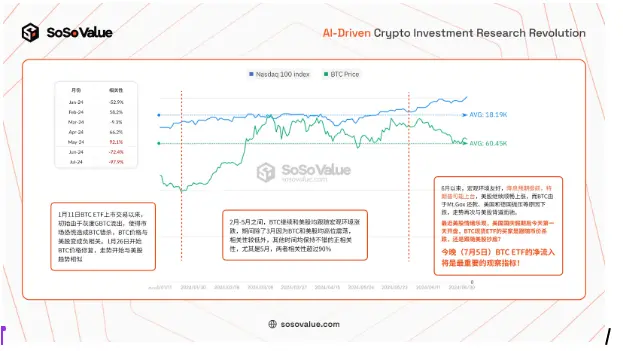
Observing the CME futures trading volume, institutional investors' sentiment is stable, and they may be waiting for a bottom-fishing opportunity. The Bitcoin futures trading volume on CME (Chicago Mercantile Exchange) did not fluctuate significantly with the large price fluctuations, indirectly proving that institutional investors are relatively calm and in a wait-and-see state. In the macro environment, and in the presence of special selling pressure due to historical reasons within the market, we believe that this unique event will provide buying momentum for long-term Bitcoin investors.
Figure 2: CME Bitcoin futures trading volume on July 5 (Data source: Bloomberg, as of July 5, 8:00 UTC)
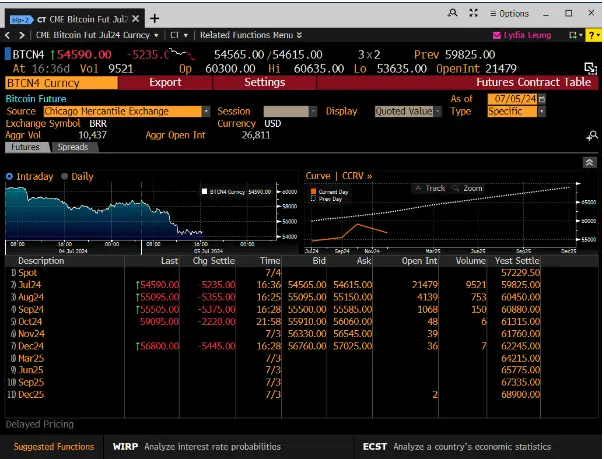
Figure 3: Historical trading volume and open interest of CME Bitcoin futures (Data source: CME)

So when will be the best time to buy? The Bitcoin spot ETF on July 5 may provide a signal. After the 1.5-day US Independence Day holiday on July 3-4, the Bitcoin spot ETF will resume trading tonight. The recent sentiment in the US stock market has been very optimistic, with NVIDIA, Microsoft, and Apple reaching new historical highs again, and investors bottom-fishing Tesla, with a return of nearly 40% in 2 weeks. Will the buyers of the Bitcoin spot ETF follow the price decline of the coin, or will they follow the bottom-fishing in the US stock market? We will wait and see. In particular, real-time trading volume and net inflow data after trading hours are core observation indicators. Higher trading volume represents stronger bottom-fishing enthusiasm, which is expected to send a signal to the market to stop the decline. If it can directly bring net inflows of funds to the chain, changing the situation of slight net outflows in the past 2 trading days (see Figure 4 for details), it will also bring actual incremental funds to the chain, further enhancing the confidence of cryptocurrency investors.
Figure 4: Historical net inflows of Bitcoin spot ETF (Data source: SoSo Value)
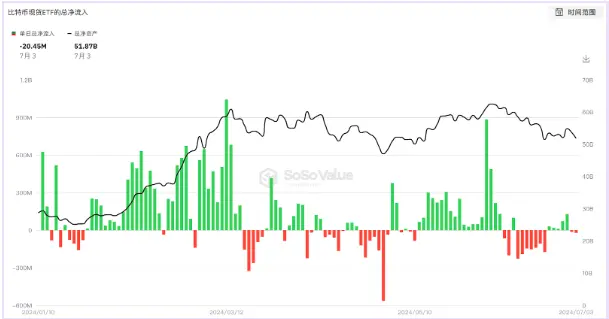
Sell-side: Nearly 200,000 Bitcoins sold by the German government and Mt. Gox?
The clear sell-side factors mainly come from two key sources of selling pressure: 1. Bitcoins seized by the German government, and 2. Bitcoins for compensation to Mt. Gox creditors.
Regarding the German government's sales, it is crucial to know when they will stop reducing their holdings. The German government has seized a total of 50,300 Bitcoins, and from June 19 to July 5, approximately 8,080 Bitcoins have been transferred out. The remaining holding is 42,270 BTC, with 83.94% of the holdings yet to be sold. There is still doubt about whether this portion will continue to be sold in large quantities in the short term, and there is a great deal of uncertainty about the selling pressure.
Figure 5: Summary of BTC transfer out from German government wallet (Data source: Arkham)
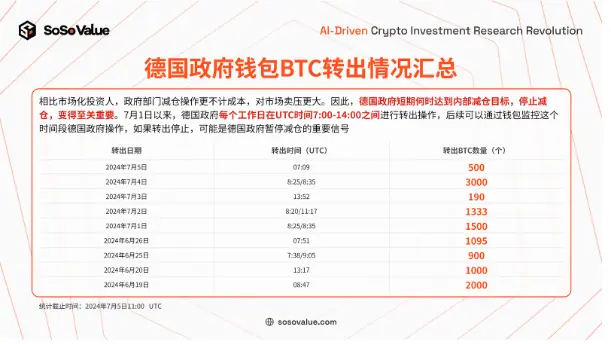
Figure 6: Holdings and transfer situation of Bitcoins held by German and US governments, and Mt. Gox (Data source: Public information compilation)
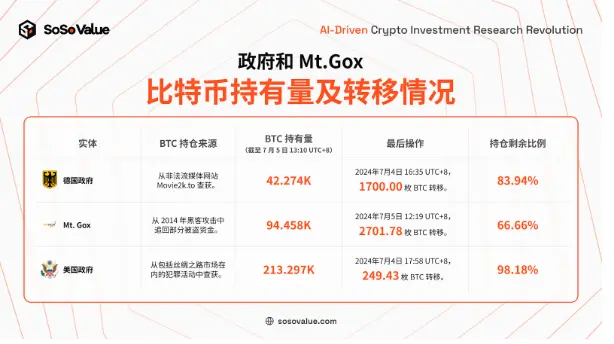
Regarding Mt. Gox, the selling pressure may be much lower than market expectations. It is expected to compensate creditors with 142,000 Bitcoins. According to information from the Japanese cryptocurrency community, more than 70% of the claims have been transferred through several rounds of OTC transactions and acquired by institutional buyers. This portion of the Bitcoins that have been acquired is not expected to bring about significant selling pressure. The remaining 30% of the Bitcoins, which may bring about large-scale selling pressure, amount to approximately 40,000-50,000. According to on-chain data monitoring, on July 5, Mt. Gox transferred approximately 50,000 Bitcoins, of which 1,544 were transferred to exchanges, and 47,228.7 Bitcoins were transferred to a new address starting with 1L7Xbx, with no further movement. Overall, the actual selling pressure from Mt. Gox may be lower than market expectations.
- July 4:_ Multiple Mt. Gox wallets conducted small transfer tests._
- July 5:_ Mt. Gox transferred over 47,228.7 Bitcoins (approximately $2.71 billion) to a new address starting with 1L7Xbx. Subsequently, this address distributed these Bitcoins to two addresses: 44,500 BTC (approximately $2.55 billion) to address 16 ArP 3…VqdF; and 2,700 BTC (approximately $154.8 million) to address 1 JbezD…APs 6. Currently, these two addresses have not had any further activity._
- July 5:_ Additionally, 1,544 Bitcoins were transferred to address 1 PKGG, worth $84.87 million. This address belongs to the Bitbank exchange, one of the five platforms supporting repayment by Mt. Gox._
- July 5:_ Multiple Mt. Gox creditors in Japan have stated to the cryptocurrency media DeepChao that they have received BTC/BCH repayments from Mt. Gox, and the funds have been deposited into the exchange accounts of Bitbank or Kraken. In addition, some have stated that they have received cash payments via international wire transfers._
Potential miner sell-offs have also become a factor in this round of decline, but this selling pressure is expected to stop with the stabilization of Bitcoin. Due to the halving of Bitcoin mining rewards at the beginning of the year, the profitability of Bitcoin miners has dropped to the lowest level in two years. According to data from F2pool on July 4, based on the current Bitcoin mining difficulty and an electricity cost of $0.06 per kWh, mainstream miners such as Antminer S19 have reached the "shutdown price," and some unprofitable miners have been forced out, and their liquidation and exit will potentially bring about selling pressure.
Figure 7: Bitcoin miner shutdown cost (Data source: f2pool)
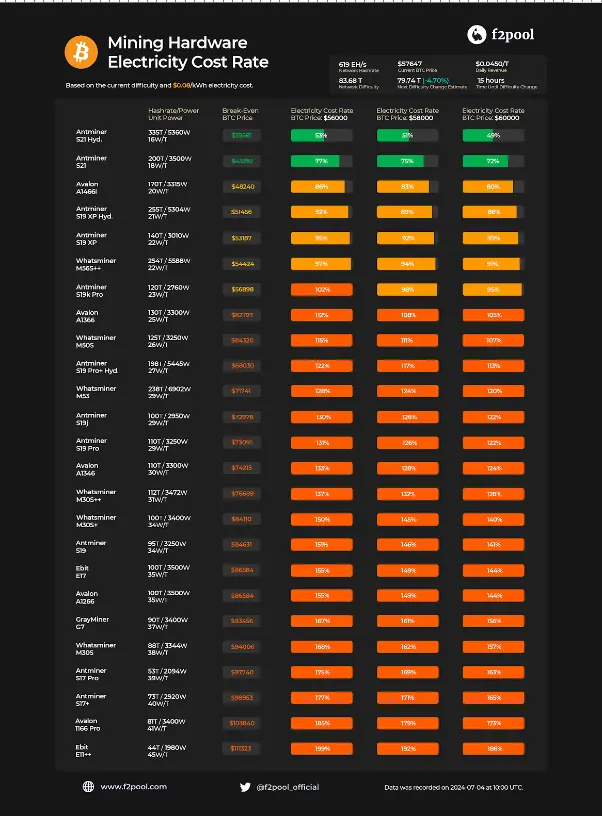
In summary, the buying pressure is based on long-term optimism, while the selling pressure stems from emotional panic brought about by special events. We believe that this unique event will provide buying opportunities for long-term Bitcoin investors. Based on past experience, the market's emotional digestion of selling pressure from a certain unique event generally does not exceed two months. The current decline in Bitcoin, which started on June 7, may gradually be digested after August 7, and the past two days of the largest single-day decline may be the lowest point of this decline.
免责声明:本文章仅代表作者个人观点,不代表本平台的立场和观点。本文章仅供信息分享,不构成对任何人的任何投资建议。用户与作者之间的任何争议,与本平台无关。如网页中刊载的文章或图片涉及侵权,请提供相关的权利证明和身份证明发送邮件到support@aicoin.com,本平台相关工作人员将会进行核查。




